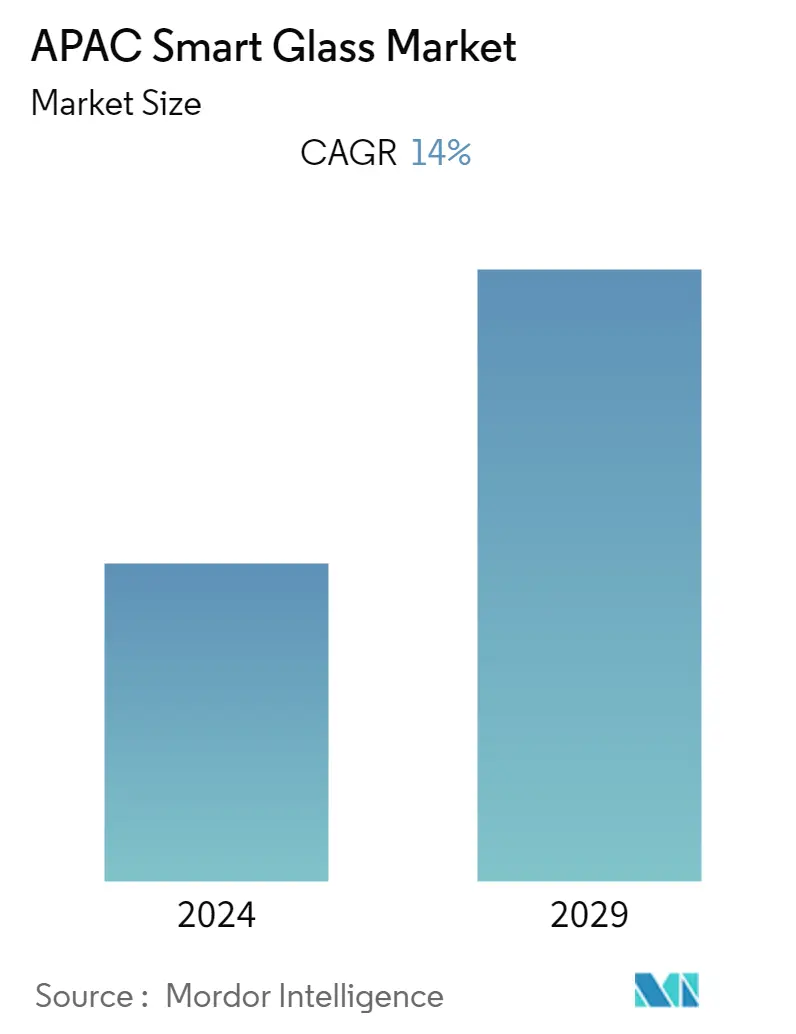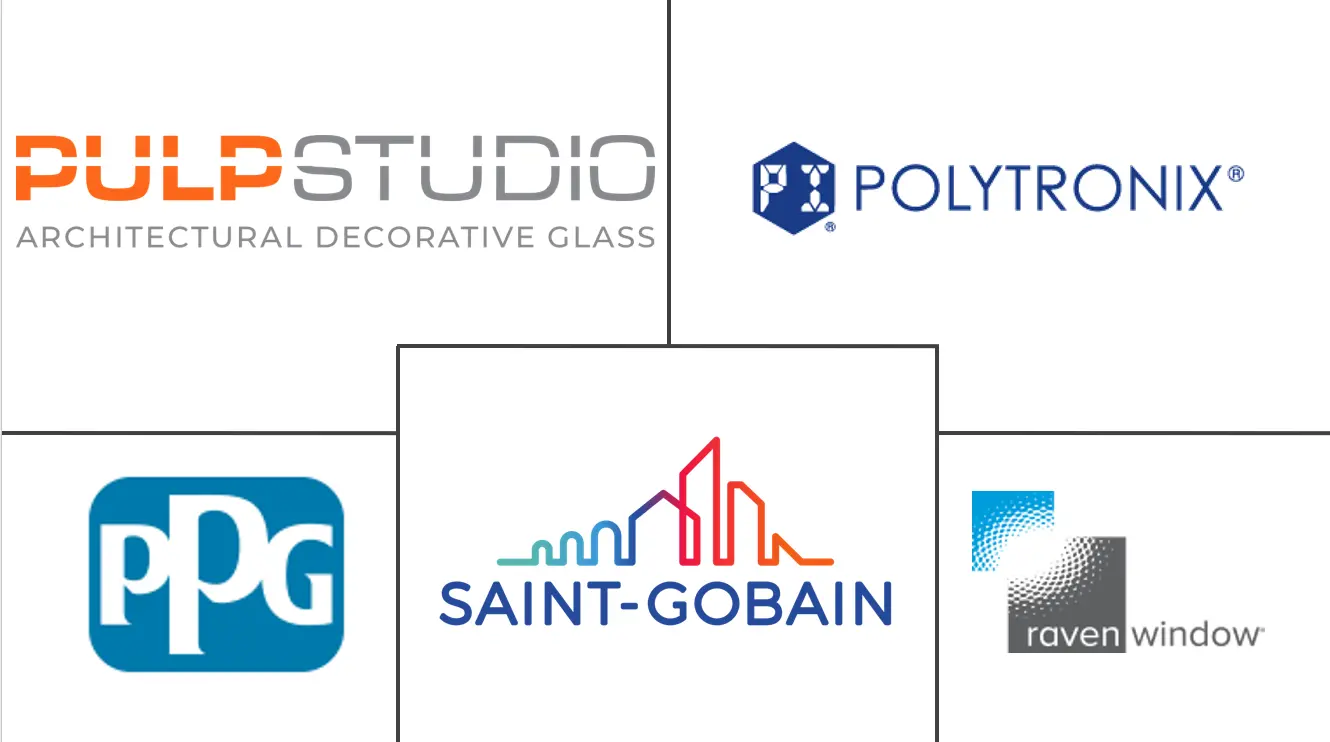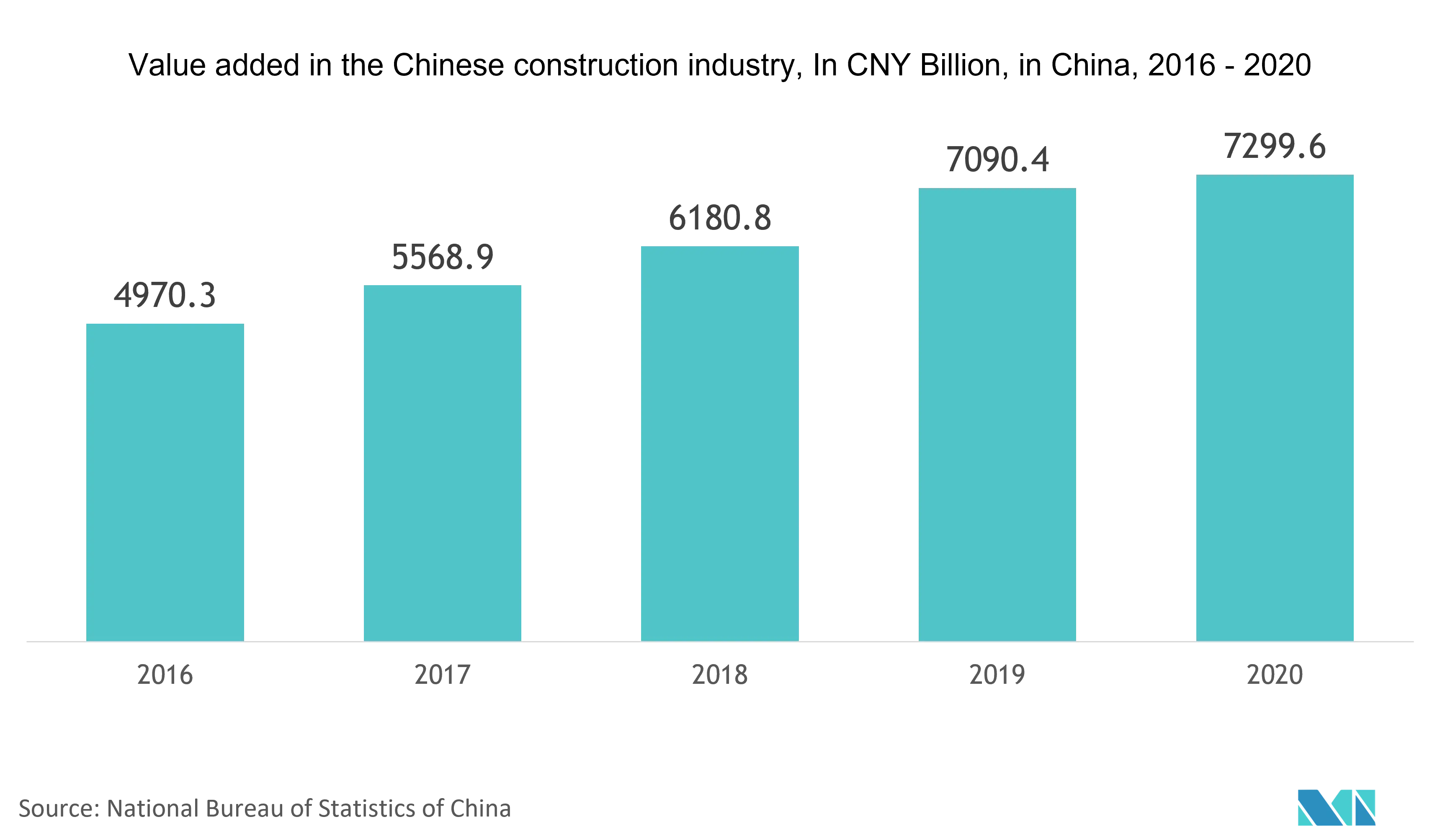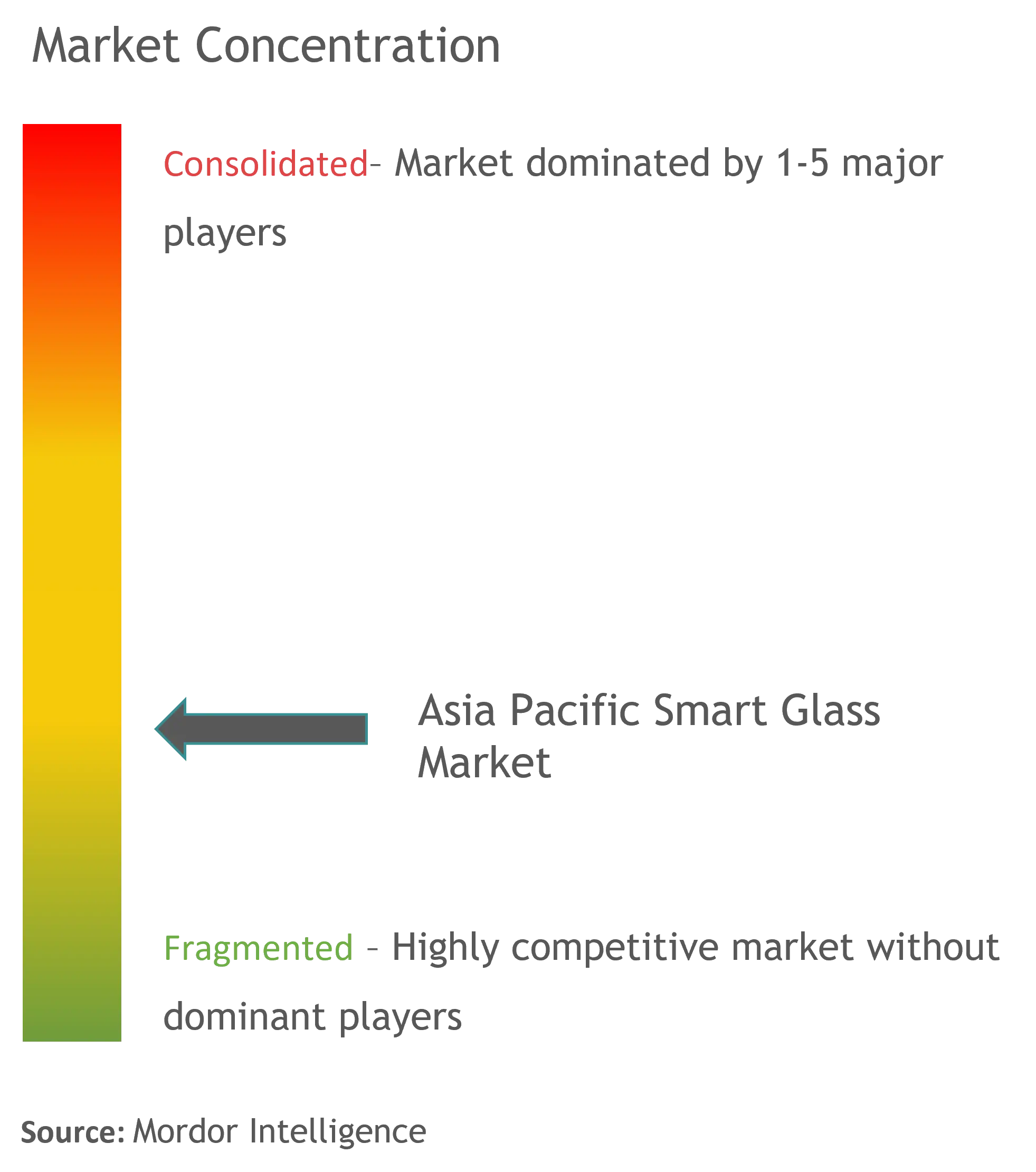APAC Smart Glass Market Size

| Study Period | 2019 - 2029 |
| Base Year For Estimation | 2023 |
| Forecast Data Period | 2024 - 2029 |
| Historical Data Period | 2019 - 2022 |
| CAGR | 14.00 % |
| Market Concentration | Low |
Major Players
*Disclaimer: Major Players sorted in no particular order |
APAC Smart Glass Market Analysis
Asia Pacific smart glass market is estimated to grow at a CAGR of 14% in the forecasted period (2021-2026). The market has been gaining significant traction due to the surging demand for energy cost savings in high-end commercial offices and residential spaces in the Asia Pacific. However, the COVID-19 pandemic has significantly affected the construction activities of the residential and commercial buildings in 2020, resulting in delayed building construction projects or halted for the short term.
With a growing focus on sustainable development, an increasing number of people have been opting for user-controlled windows in buildings. Smart glass manufacturers have been actively investing in research and development to cut production costs by implementing newer technologies and low-cost raw materials.
There has been a great amount of research and development going on in the region on smart glasses. For instance, in recent years, researchers at Shanghai University have designed the first smart window, which can produce electricity. The window acts like a solar panel and uses Vanadium dioxide film to produce electricity. Such developments are expected to provide further growth opportunities to the market, especially in offices, residential homes, and hotels.
Also, Scientists at the Nanyang Technological University, one of Singapore's engineering research institutes, have developed a unique liquid window panel that can block sunlight to regulate solar transmission into a room. Besides this, the panel can simultaneously trap thermal heat received from sunlight, gradually release it later, and help regulate indoor temperature.
The majority of the smart glass growth in the region is expected to be observed in the building sector, taking advantage of the significant cost savings and energy efficiency. Employees and residents are looking forward to benefiting from the increased natural light and access to views of the outdoors, which can improve both their health and productivity.
However, due to the pandemic, construction projects' demand has fallen due to poor business sentiments, lower operating surpluses and incomes, diversion of funds for COVID-19 management, and liquidity problems. There has been a decrease in construction activities and supply chain disruptions that have resulted in projects being delayed or halted for the short term, restraining the market's growth.
APAC Smart Glass Market Trends
This section covers the major market trends shaping the APAC Smart Glass Market according to our research experts:
Construction industry is expected to have further growth opportunities in the market
Smarter construction processes and methods are influencing the construction industry in the region. As per the National Bureau of Statistics of China, it is projected that the construction revenue in China will amount to approximately USD 3.812 billion by 2024. China has become one of the largest construction markets in the world. In 2020, the construction industry value in the China region amounted to USD 1,049 billion U.S. dollars. As the government has planned to focus on improving the infrastructure in small and medium-sized cities, the construction industry is expected to maintain a continuous growth at around 5% annually, as per the National Bureau of Statistics of China.
Various initiatives for clean technology, energy conservation, and sustainable use of energy are driving the customers to use different products, which would serve their purpose. The region is considered to be the fastest-growing economic region, with countries such as China and India developing at a rapid rate. Also, the emerging economies, such as Malaysia, Singapore, and others, are experiencing growth in their industrial, construction, and infrastructural sectors. This economic development has created a need for enhanced infrastructure; thus, the construction of malls, hospitals, and other buildings is growing at a high pace. The growing construction sector in these countries is expected to influence the smart glass market.
In Singapore, buildings are the second largest energy consumers, using almost a third of the electricity. Most of the modern building facades are often as much as 80% glass, which makes them less compatible with the sustainability and energy efficiency goals, as mandated by the government, to cope with urbanization and climate change. Thus, installing smart-tinting windows can reduce a building’s energy consumption by 20%, on average, as compared to conventional glass, thus, reducing the load on the heating, ventilation, and air-conditioning systems.
Also, increasing urbanization and commitments to conserve resources and reduce greenhouse gas emissions will further create a scope for the adoption of smart glass in the region. Countries, such as China, made significant progress in developing national green building standards. In recent years, The Ministry of Housing and Urban-Rural Development of China set clear goals to achieve the development of green buildings by 2020, in the 13th Five Year Plan for Building Energy Efficiency and Green Building Development. The Chinese government has mandated green building in government projects and has also used market-based instruments (like subsidies and public procurement) to promote green building.
Similarly, Korea Green Building Council also recognizes that the deployment of green buildings is one of the essential factors in the construction sector, with an aim to build sustainable and eco-friendly cities. This is impacting the adoption of smart glass in the region.

Japan region witnesses significant growth opportunities in the market
Smart glass is primarily used in the region to improve passenger experience in the transportation sector. For instance, AGC’s light control glass, using Research Frontiers’ SPD-SmartGlass, is installed in one of the trains of the Japan Railway Construction, Transport, and Technology Agency. This window glass, mounted in the train, combines a thin, chemically-strengthened glass with SPD-SmartGlass, to reduce weight by 30% and improve passenger comfort.
There have been increasing applications in the field of transportation that are creating immense demand for smart glass in the region. Smart glass has found a large-scale application, particularly in the automotive industry, in sunroofs, and exterior and interior automatic dimming rear-view mirrors. In fact, as most of the smart glass products are chemically toughened, they are far lighter than the traditional glass used in the automotive sector when installed in automobiles, helping automakers gain more fuel efficiency and meet regional emission standards.
According to METI (Ministry of Economy, Trade, and Industry) Japan, In 2020, approximately 8.07 million motor vehicles were produced in Japan, which is slightly down from about 9.68 million units in the previous year. The decrease was primarily due to the production halt during the Covid-19 pandemic. The production volume of motor vehicles in Japan included passenger cars, trucks, and buses, of which passenger cars accounted for the majority.
Smart glass is also increasingly being adopted in the construction sector in the region. According to the Ministry of Finance Japan, the construction industry in Japan generated sales of approximately JPY 133.9 trillion in 2020. In 2020, total construction investment in Japan was estimated at around JPY 60.9 trillion, with building construction accounting for almost 50% of these investments, forecasted to increase to JPY 62.7 trillion in 2021, according to the Ministry of Land, Infrastructure, Transport, and Tourism, Japan.
Windows are considered the most inefficient part of a building and are responsible for heat loss in cold months and solar heat gain in warm months. Some researchers also stated that sunlight entering a house could increase cooling loads by 20%. In some cases, glare from the sun can make it difficult to see an LCD screen, requiring the blinds to be pulled, negating the benefits of natural light. These are expected to bring further growth opportunities to the market in the region.

APAC Smart Glass Industry Overview
The Asia Pacific Smart Glass Market is fragmented. Various established international brands, domestic brands, as well as new entrants, form a competitive landscape. The major players are increasingly seeking market expansion through various strategic mergers and acquisitions, innovation, increasing investments in research and development.
- April 2021: SageGlass, a subsidiary of Saint Gobain, was chosen by Bagmane Group, one of the largest build-to-suit real estate developers, to create one of the largest smart glass installations in the world. The company will provide 200,000 square feet of SageGlass Harmony electrochromic glass, controls, and software for Rio Business Park, a 1.6 million square foot office development in Bangalore, India.
- October 2021: Mixed reality (AR/MR) startup Thirdeye announced a partnership with Hong Kong-based IT vendor GO VR Immersive to expand the availability of its X2 MR smart glasses to the Asia-Pacific region. The company will be supplying headsets to APAC frontline workers in education, architecture, and industrial environments with their rugged MR solution.
APAC Smart Glass Market Leaders
-
Polytronix Inc
-
PPG Industries
-
Saint-Gobain
-
Pulp Studio
-
RavenBrick LLC
*Disclaimer: Major Players sorted in no particular order

APAC Smart Glass Market News
- September 2021: Xiaomi launched its own smart glasses, which are capable of taking photos, displaying messages and notifications, making calls, providing navigation, and translating text right in real-time in front of eyes. The glasses also have an indicator light that shows when the 5-megapixel camera is in use.
- September 2021: Facebook Inc, in partnership with Ray-Ban, launched its first smart glasses named 'Ray-Ban Stories' that allow wearers to listen to music, take calls, or capture photos and short videos and share them across Facebook's services using a companion app.
APAC Smart Glass Market Report - Table of Contents
1. INTRODUCTION
- 1.1 Study Assumptions and Market Definition
- 1.2 Scope of the Study
2. RESEARCH METHODOLOGY
3. EXECUTIVE SUMMARY
4. MARKET INSIGHTS
- 4.1 Market Overview
- 4.2 Value Chain Analysis
-
4.3 Porter's Five Forces Analysis
- 4.3.1 Threat of New Entrants
- 4.3.2 Bargaining Power of Buyers
- 4.3.3 Bargaining Power of Suppliers
- 4.3.4 Threat of Substitutes
- 4.3.5 Intensity of Competitive Rivalry
- 4.4 Assessment of the Impact of COVID-19 on the Market
5. MARKET DYNAMICS
-
5.1 Market Drivers
- 5.1.1 Increasing focus on Energy Conservation and Environment Friendly Technologies
- 5.1.2 Government Regulations
- 5.1.3 Increasing demand for energy savings techniques
-
5.2 Market Restraints
- 5.2.1 Lack of Awareness of Smart Glass Benefits
- 5.2.2 Technical Issues with the Usage of Large Size Smart Glass
6. MARKET SEGMENTATION
-
6.1 Technology
- 6.1.1 Suspended Particle Devices
- 6.1.2 Liquid Crystals
- 6.1.3 Electro-chromic Glass
- 6.1.4 Passive Smart glass
- 6.1.5 Active Smart glass
- 6.1.6 Others
-
6.2 Applications
- 6.2.1 Construction
- 6.2.1.1 Residential Buildings
- 6.2.1.2 Commercial Buildings
- 6.2.2 Transportation
- 6.2.2.1 Aerospace
- 6.2.2.2 Rail
- 6.2.2.3 Automotive
- 6.2.2.4 Others
- 6.2.3 Energy
- 6.2.4 Consumer Electronics
- 6.2.5 Others
-
6.3 Country
- 6.3.1 China
- 6.3.2 Japan
- 6.3.3 India
- 6.3.4 South Korea
- 6.3.5 Rest of Asia Pacific
7. COMPETITIVE LANDSCAPE
-
7.1 Company Profiles
- 7.1.1 Polytronix
- 7.1.2 PPG Industries
- 7.1.3 Scienstry Inc
- 7.1.4 Saint-Gobain
- 7.1.5 Pulp Studio
- 7.1.6 Ravenbrick
- 7.1.7 Nippon
- 7.1.8 Smartglass International
- 7.1.9 Pro Display
- 7.1.10 Gentex Corporation
- 7.1.11 Hitachi Chemical
- 7.1.12 LTI Smart Glass
- 7.1.13 Citala
- 7.1.14 Asahi Glass Corporation
- 7.1.15 View, Inc.
- *List Not Exhaustive
8. INVESTMENT ANALYSIS
9. FUTURE OF THE MARKET
** Subject To AvailablityAPAC Smart Glass Industry Segmentation
Smart glasses are special types of glasses, which can change from being clear to translucent or even pellucid to opaque. It is primarily used to block light, heat, and glare. This technology is very helpful to reduce the cost of lighting, air conditioning, curtains blinding, or heating of the room. There are two types of smart glasses: active type and passive type. The active type of smart glass responds to the electrical stimulus to make the glass, while the passive type is triggered by light or heat. Active glasses are used in sectors like architecture, healthcare, and automotive, etc. This type of smart glass uses the technologies like Suspended Particle Devices (SPDs), electrochromic devices, among others.
APAC Smart Glass Market Research FAQs
What is the current APAC Smart Glass Market size?
The APAC Smart Glass Market is projected to register a CAGR of 14% during the forecast period (2024-2029)
Who are the key players in APAC Smart Glass Market?
Polytronix Inc, PPG Industries, Saint-Gobain, Pulp Studio and RavenBrick LLC are the major companies operating in the APAC Smart Glass Market.
What years does this APAC Smart Glass Market cover?
The report covers the APAC Smart Glass Market historical market size for years: 2019, 2020, 2021, 2022 and 2023. The report also forecasts the APAC Smart Glass Market size for years: 2024, 2025, 2026, 2027, 2028 and 2029.
APAC Smart Glass Industry Report
Statistics for the 2024 APAC Smart Glass market share, size and revenue growth rate, created by Mordor Intelligence™ Industry Reports. APAC Smart Glass analysis includes a market forecast outlook 2029 and historical overview. Get a sample of this industry analysis as a free report PDF download.



